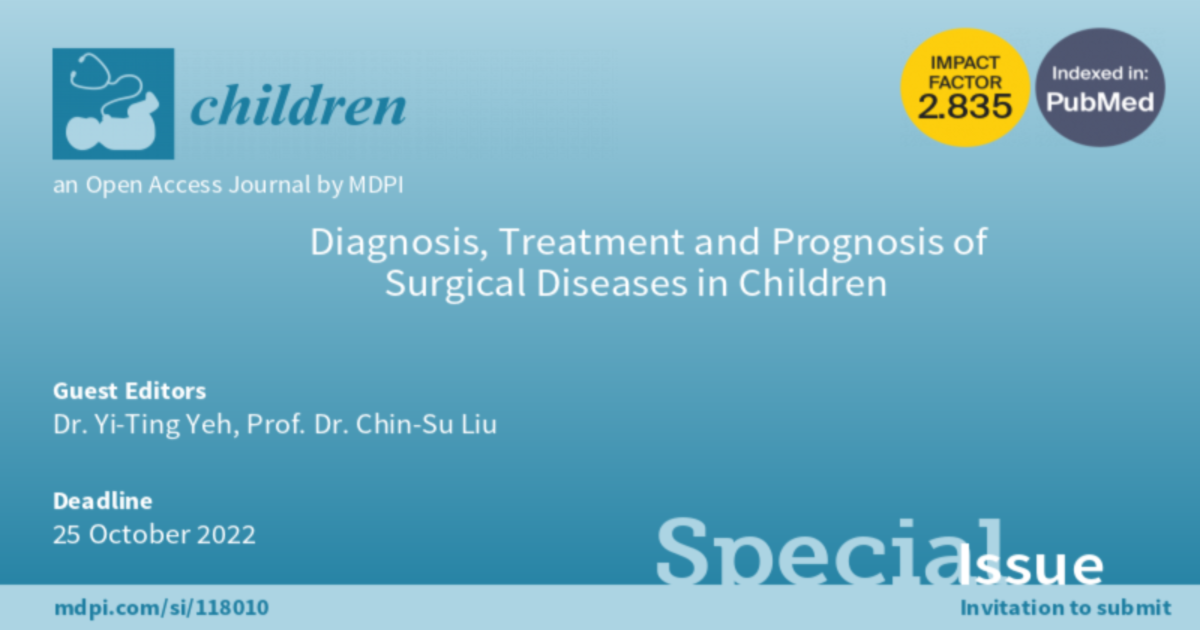Diagnosis, Treatment and Prognosis of Surgical Diseases in Children
A special issue of Children (ISSN 2227-9067). This special issue belongs to the section "Pediatric Surgery".
Deadline for manuscript submissions: closed (25 October 2022) | Viewed by 13961

Special Issue Editors
Interests: laparoscopic surgery; abdominal surgery; surgical oncology; minimally invasive surgery; hernia surgery; gastrointestinal surgery; colorectal surgery; laparoscopic cholecystectomy; advance laparoscopic surgery; hepatobiliary surgery
Interests: genitourinary surgery; pediatric thoracic surgery; abdominal surgery; general pediatric surgery; anal surgery; congenital malformation; liver transplant surgery
Special Issue Information
Dear Colleagues,
It is my great honor to serve as a guest editor of this Special Issue of Children entitled Diagnosis, Treatment, and Prognosis of Surgical Diseases in Children.
Surgical diseases in infancy and childhood encompass a wide range of conditions including congenital disorders, acquired/infectious diseases, trauma, and pediatric oncology. A thorough understanding of the presentation, diagnosis, treatment, post-operative management, and follow-up/transitional care is imperative for practitioners of various specialties to maintain a high standard of care, providing optimal outcomes for our patients.
The goal of this Special Issue is to present original research, reviews, clinical studies, brief reports, case reports, and editorials covering the advances and innovations in diagnostic approaches, multidisciplinary management, and translational and basic research regarding surgical diseases in infancy and childhood.
I look forward to receiving your contributions.
Dr. Yi-Ting Yeh
Prof. Dr. Chin-Su Liu
Guest Editors
Manuscript Submission Information
Manuscripts should be submitted online at www.mdpi.com by registering and logging in to this website. Once you are registered, click here to go to the submission form. Manuscripts can be submitted until the deadline. All submissions that pass pre-check are peer-reviewed. Accepted papers will be published continuously in the journal (as soon as accepted) and will be listed together on the special issue website. Research articles, review articles as well as short communications are invited. For planned papers, a title and short abstract (about 100 words) can be sent to the Editorial Office for announcement on this website.
Submitted manuscripts should not have been published previously, nor be under consideration for publication elsewhere (except conference proceedings papers). All manuscripts are thoroughly refereed through a single-blind peer-review process. A guide for authors and other relevant information for submission of manuscripts is available on the Instructions for Authors page. Children is an international peer-reviewed open access monthly journal published by MDPI.
Please visit the Instructions for Authors page before submitting a manuscript. The Article Processing Charge (APC) for publication in this open access journal is 2400 CHF (Swiss Francs). Submitted papers should be well formatted and use good English. Authors may use MDPI's English editing service prior to publication or during author revisions.
Keywords
- pediatric
- pediatric surgery
- diagnostic modalities
- multidisciplinary management
- transitional care
- translational research






